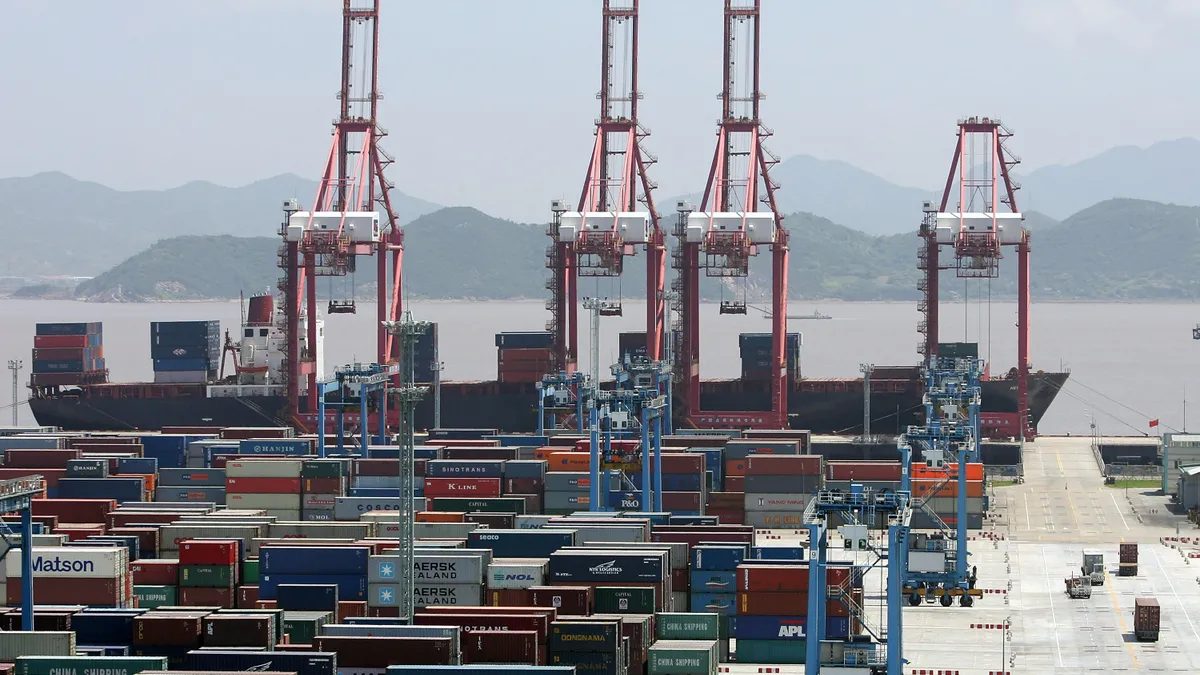When it comes to relief from Section 301 China tariffs, analysts and economists don't expect a Christmas miracle for U.S.-based importers.
China faces a deadline of Dec. 31 to meet its purchase agreements specified under the phase 1 trade deal. China agreed to purchase $200 billion more in goods and services from the U.S. from Jan. 1, 2020 to Dec. 31, 2021. When the countries brokered the deal in December 2019, they also canceled an upcoming tranche of tariffs set to take effect, primarily on consumer goods.
As of this October, however, China has only met 62% of its target imports, per an analysis by Chad Brown, Reginald Jones senior fellow at the Peterson Institute for International Economics.
"I have a hard time seeing that there's going to be breakthroughs or ... that there'll be a phase 2 or phase 3" of the China trade deal, said James Green, director of government affairs and public policy at Google, on a Flexport webinar Nov. 10.
And without a breakthrough in the years-long trade war, respite from the Section 301 China tariffs remains unlikely.
"China needs to live up to its commitments," a senior U.S. Trade Representative official told reporters on a press call in October. "It's up to China to demonstrate whether or not they're willing to do that."
Many analysts said the deal was doomed from the start. "China has never been on pace to meet the goods purchase commitments," Brown wrote.
Then, when world trade plummeted during the pandemic, the purchase goals became even more elusive. U.S. exports to China of aircraft, autos, soybeans, raw hides and energy products have remained below phase 1 targets, according to Brown's analysis.
"US exports of those products have yet to recover, and without them, China has little hope of meeting the overall purchase commitments," Brown wrote.
'Chunky' tariffs meet inflation
Duties of up to 25% apply to $370 billion worth of goods from China. Last year, the U.S. imported some $435 billion worth of products from China.
"It's a a pretty chunky tariff package that's still in place," Chris Rogers, principal supply chain economist at Flexport, said on the Nov. 10 webinar.
Groups representing supply chains and retailers have been pushing for the removal of Section 301 China tariffs since they took effect in 2018.
The tariffs saddled many importers with higher total landed costs, as the short timelines left little time to adjust sourcing. U.S. importers have paid more than $110 billion in 301 tariffs since they began, according to a Nov. 15 letter from more than 20 industry associations sent to U.S. Trade Representative Katherine Tai and Treasury Secretary Janet Yellen.
Section 301 China tariffs
| List | Import value | Tariff rate |
|---|---|---|
| 1 | $34 billion | 25% |
| 2 | $16 billion | 25% |
| 3 | $250 billion | 25% |
| 4 | 4A: $120 billion 4B: $180 billion | 4A: 7.5% | 4B: suspended |
Source: USTR
Inflationary pressures in today's economy add to costs in the supply chain. The Consumer Price Index, a measure of inflation, was up more than 6% in the U.S., the largest 12-month increase since November 1990.
Yellen and former Treasury Secretary Jacob Lew told Reuters and CNBC, respectively, that removing tariffs would reduce inflation, as tariffs can make inputs more expensive, and businesses often pass a portion of those costs on to the end customer.
But there's little indication from the Biden administration that the tariffs will recede, with no movement on trade relations following a meeting between President Joe Biden and President of China Xi Jinping Nov. 15.
Tai has retained her stance of being firm on China. "Section 301 ... is a very, very important tool," she said in October at the Center for Strategic and International Studies.
The acceptance phase
For supply chains reliant on imports from China, tariffs are at least a medium-term reality, if not a long-term one. About 60% of Flexport webinar attendees expect tariffs and tensions to continue, according to a poll conducted during the webinar.
Managers have come around to the fact and planned for the tariffs in their total landed costs, said Gretchen Blough, customs brokerage manager at Logistics Plus.
"They're not liking the tariffs, but they're at least accepting of them," Blough said.
Some businesses have diversified or nearshored in pursuit of alternatives to China-only sourcing. But that requires a lot of legwork to find new suppliers and build relationships.
"It's not always easy to switch your sourcing from country to country," Blough said.
"It's a a pretty chunky tariff package that's still in place."

Chris Rogers
Principal Supply Chain Economist at Flexport
The Biden administration acknowledged some of the Section 301 China tariffs are harmful to businesses and consumers.
"We place a lot of weight in what we hear from our businesses, especially our small- and medium-sized businesses that certainly have been impacted by the tariffs," Tai said in October at CSIS.
A reporter on the October press call asked why the administration wouldn't refund tariffs, if they're determined to be a burden to small businesses.
"It presents some administrative challenge," a senior USTR official said in response.
Tai did say she would restart an exclusion process for tariffs, and the USTR office requested comments on tariff exclusions. Businesses have submitted more than 2,000 comments on tariff exclusions.
Google's Green predicted a broadening of the exclusion process, "so that the actual impact of the tariffs will be less and less," he said. "So, not exactly receding, but maybe less hurtful."
This story was first published in our Procurement Weekly newsletter. Sign up here.













